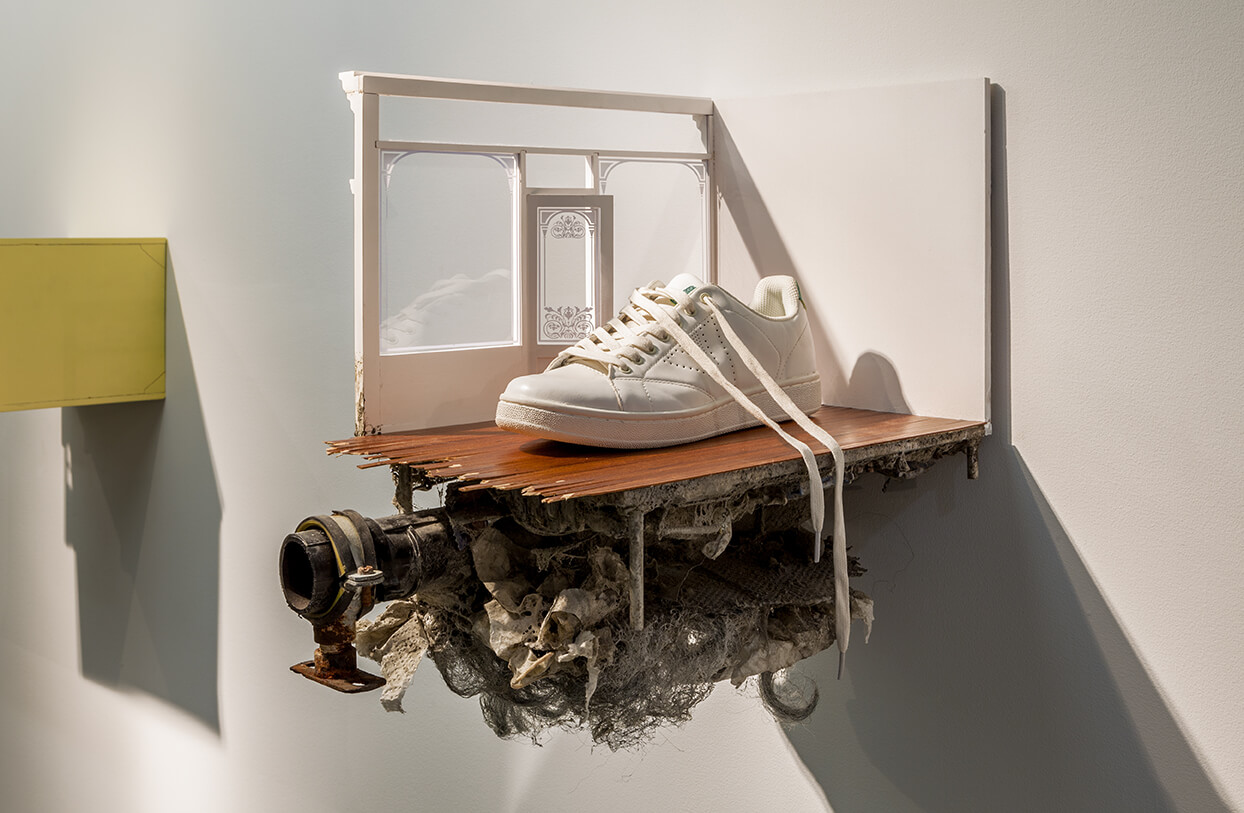Mathis Altmann: Foul Matters | Frieze d/e
Sep 01 2016

Mathis Altmann is a Switzerland-based, German sculptor known for dense, precise miniatures, often depicting the clutter and chaos left in the wake of human industry. His recent compositions enact an exuberant, comic amplification of the word “stuff”. In his layered geological assemblages, Altmann culls from the rough-hewn meat of low-end domestic building materials: crumbling dry-wall, wire mesh, PVC water pipes, light bulbs, dangling power cords and electrical wires from unfashionable tech gadgets. The results are tense, compact sculptures with an amphetamine-laced, nervous energy that recall the hardboiled suspense of Raymond Chandler or the low-orbit sic-fi of Neal Stephenson.
For Foul Matters at New York’s Swiss Institute this year– his first institutional show in the US, and the last show at the organization’s Wooster Street space– Altmann presents nine new, dramatically spot-lit works (all 2016) that see his usually aggressive stride become a more leisurely, self-conscious excursion. There is a formality and reserve to the show, comprising sculptures in which walls become both an abstract theme and physical support– though with less material density than in previous efforts. In his slackening of pace and stiffening of mood, the artist’s witty, acidic humor gets louder. The maquette-like wall piece Yes Vacancy, for example, features an overhead view into an architectural model of two empty rooms where curtains are suspended in a sensational gust of wind. The interior is lit harshly from above, casting dramatic shadows between the rooms. This tension is amusingly diffused by some dozen dead flies scattered on the model room’s walls (flaunting the “wind” suggested by the curtains). For Domestic Waste Police, a miniature two-panel white door with a modest stained glass window appears on the base of a grey plastic bin. The door could belong to some suburban parish church, left slightly ajar and offering a peek into the in. The flight grey of the barren, factory-frsh plastic inside (also viewable from above the bin’s mouth) quickly deflates whatever world the architectural model might hint at.
Despite religious references, the real creed being plumbed here isn’t so much denomentational as it aesthetic. Altmann’s show seems to troll contemporary design sense: that kind of ahistorical “minimalism” about which Silicon Valley’s made men crow about on Medium blogs and LinkedIn disquisitions. In Upper Class Fuckery, we see two, red twin-sized beds with replica 19th century frames brought into the present, placed on a mirrored floor. Atop the beds, two hilariously realistic brown turds luxuriate in gentle repose like neutered house cats. Meanwhile in LO*KUS LAB, a white tennis shoe– the sort a junior art director in New York might wear in summer months– is prominently displayed the hard floor of a simple glass storefront. Its untarnished white lace dangles past the floor’s edge, which gives way to a filthy paper towel and wire mesh insulation below. A dismembered, empty sewer pipe stands in for the tangled infrastructure that supports the vacant elegance of the scene– and the shoe’s absent owner.
The latest work in the show moves in a different direction: a real-life brown leather sofa leaning sharply against a wall opposite seven of Altmann’s miniature compositions. Its surface is coated with a clear resin, upon which the artist has strewn thousands of mealworm husks. These empty shells have appeared in at least one prior work by the artist; they seem to suggest the idea of dried, dusted vessels evacuated of substance or animating force. The work is less engaging than what Altman produces when we works on a smaller scale. Perhaps, though, the slight shortchanging here is the point. The poster advertising the exhibition featured an appropriated woodcut illustration of a grandly scene– a trashy phase used by servants in pre-20th century Scotland to warn passersby that waste water was about to be thrown out of a window.
Altmann’s work isn’t interested so much in the waste itself: more important, maybe, is the experience he invites as he draws our attention to that waste’s withdrawal. After all, as the disposable cultures of fast architecture and “indispensable” tech increasingly espouse a mute, sanitized design aesthetic– what better antidote than the unseen filth festering behind every drywall and chaste intention?
